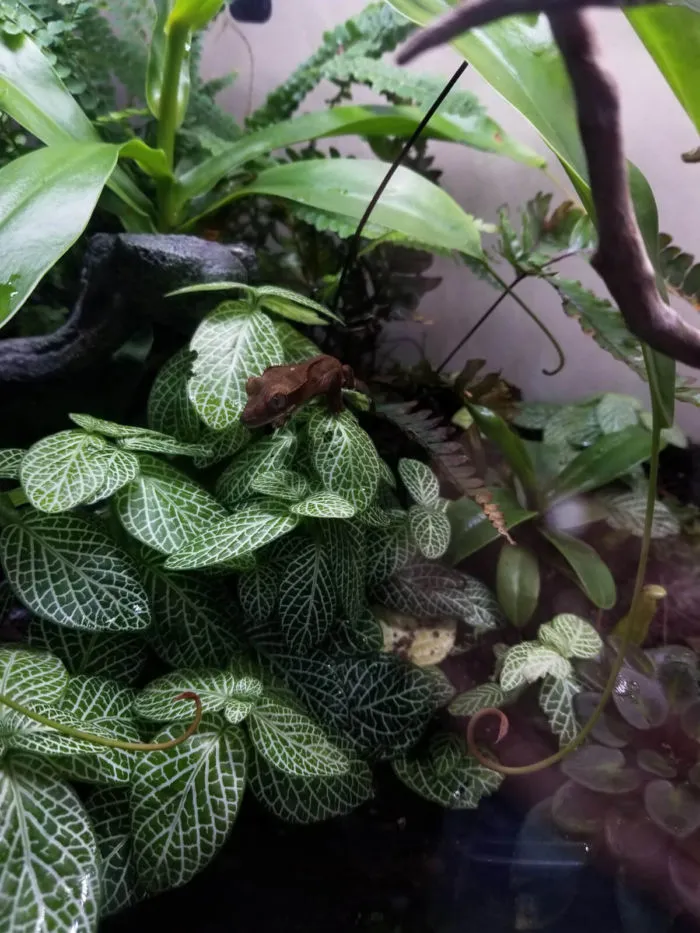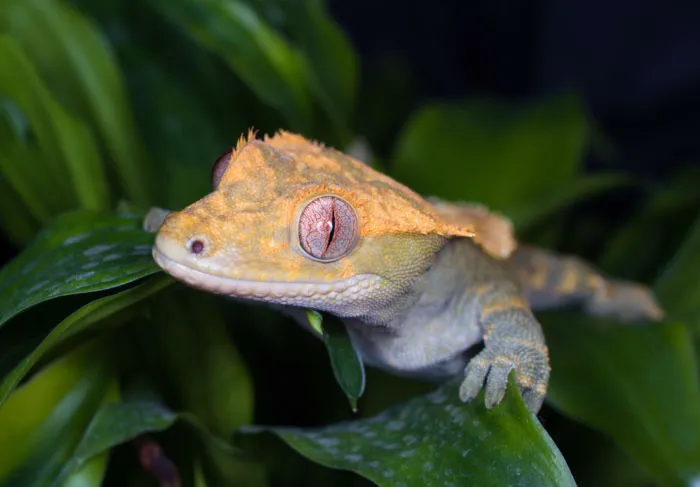 Although known to mostly spend their time climbing branches and foliage, some crested geckos are often found preferring to stay on the ground for various reasons.
Although known to mostly spend their time climbing branches and foliage, some crested geckos are often found preferring to stay on the ground for various reasons.
Why Your Crested Gecko Is On The Ground: Crested geckos are arboreal lizards, which means they are usually found on higher branches and other climbing structures around them. Occasionally, however, they spend more time on the bottom of their enclosure and although this may seem worrisome, it isn’t necessarily alarming. The crested gecko might prefer the humidity on the ground level or perhaps it just can’t climb.
As long as your crested gecko is looking healthy and behaving normally, its time laying around on the bottom is nothing to worry about. Crested geckos look for places where they feel safe and secure and sometimes that just happens to be the bottom of their enclosure.
Table of Contents
Crested geckos need foliage in their enclosure
If a crested gecko doesn’t have enough climbing structures in its tank, it will have no choice but to spend more time on the ground. More than half their
Crested geckos are expert climbers and even enjoy climbing up the glass of their
When there is a lack of things they can climb on, crested geckos can be noticed curling up on the bottom of their
This will also help them feel safer as they prefer being hidden in branches and foliage as opposed to being exposed and easily visible.
Looking for moisture
The crested gecko thrives in humidity, which can be maintained with regular misting as well as a substrate that retains moisture. When the humidity in the terrarium is too low, the crested gecko is more likely to stay on the ground looking for more moisture.
Similarly, it could also be a cause for concern if the humidity is consistently too high. This would cause the
Shedding also causes the crested gecko to spend more time on the bottom looking for additional moisture. It is essential for humidity to be increased in the
Shedding can take up to three to seven days and during those days, the crested gecko won’t be able to stick to surfaces properly. This is an additional reason due to which it will be seen spending more time on the ground.
Additionally, if you notice that your crested gecko is constantly looking to bury itself in the substrate and stay there for a while, it could be a sign that you need to check the temperature in their
If your Crested gecko has problems with shedding, read our article on bathing Crested geckos – we show you a great method you can use to help your Crestie shedding without stressing the animal too much!
Keep the crested gecko’s feet and tank clean
If you have noticed your crested gecko sliding down the glass surfaces of its
Having trouble sticking to glass or other material in their enclosure is yet another reason why you may find your crested gecko spending more time on the bottom.
Dirt can easily accumulate under their feet and this hampers their ability to climb and stick on surfaces around them.
Creating a sauna for them or cleaning their toes with a q-tip can easily solve this common problem. When their feet are clean, they will tend to stick more to surfaces.
Crested geckos are active at night
No doubt, it can be a bit stressful to see your crested gecko lazily lying at the bottom of his tank during the day but you need to remember that these lizards are known to be more active at night.
Crested geckos are not too fond of bright lights and would prefer to stay hidden under some foliage or between some branches during the day.
This is also the time when they sleep so if you don’t see them move for an hour or two at a stretch, don’t necessarily assume that something is wrong.
At night, however, they mostly stay awake and enjoy climbing around and jumping from one side of the
That’s why Crested geckos do not need light at night. Having lights on at night can even result in health problems! Read more on that in our article here!

Gravid crested geckos spend more time on the bottom
If you have a female crested gecko and your notice she is spending more time on the bottom of her
Gravid crested geckos move around the floor of the
If you notice this behavior, you could help her by setting up an egg-laying box for her.
When to worry about your crested gecko’s behavior
Crested geckos have a tendency of switching between being lazy or extremely active. Sometimes they won’t stop leaping around their
However, if your crested gecko seems overly lethargic and doesn’t seem to be moving much at all, you may want to check for illnesses.
Shedding and being stressed could be the most common reasons why it’s laying in the same spot or burying itself in the substrate, but sometimes this could also be because they are suffering from some illness or injury so pay close attention to their actions.
Bone and joint issues in crested geckos make them reluctant to climb around their
Related Questions:
How to tell if a crested gecko is dehydrated?
A dehydrated crested gecko is easy to spot. You will notice that its skin is appearing wrinkly and feels dry. Your gecko will seem quite lethargic along with having visibly sunken eyes. Crested geckos can easily get dehydrated, so it is essential that you mist regularly and always have water available for them.
What are the signs that your crested gecko is stressed?
Being outside their
- Enchi Ball Python: A Unique and Stunning Morph of Python regius - March 27, 2025
- Emerald Tree Monitor: The Enigmatic Green Guardian of the Rainforest - March 26, 2025
- The Egyptian Cobra (Naja haje): A Fascinating Serpent - March 25, 2025
